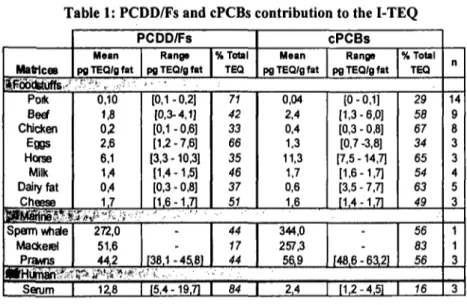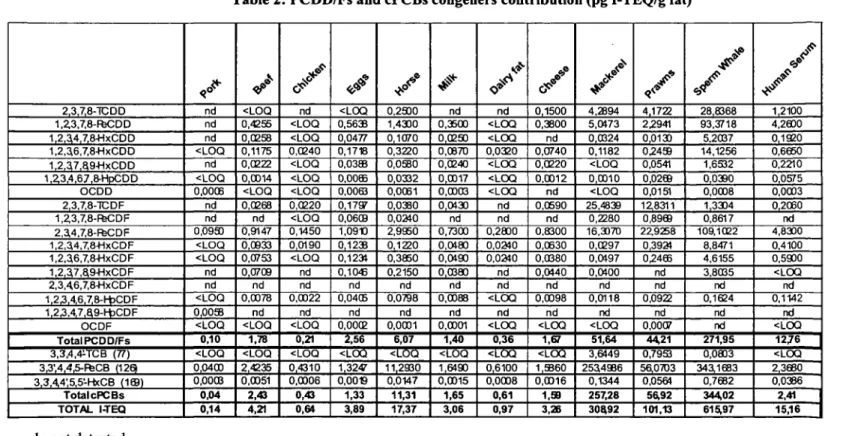RISK EVALUATION - POSTERS
Contribution and Importance of Non-Ortho (Coplanar) PCBs for the
I-TEQ Evaluation in "Dioxins Analysis" of Biological Matrices
Jean-Francois Focant. Gauthier Eppe, Jean-Sebastien Houziaux, Celine Xhrouet, Jean-Emmanuel Andr^, Dominique Dipede and Edwin De Pauw
Mass Spectrometry Laboratory, University of Liege, B6c Sart-Tilman, B-4000 Liege, Belgium e-mail: JF.Focant@ulg.ac.be
Introduction
Dioxins (this term covering PCDD/Fs) and Dioxin-like PCBs are a class of organic compounds which have similar physical and biological properties. The substitution pattern of some PCBs allow them to adopt a planar geometty similar to the one of PCDD/Fs. Due to their respective affinity to bind the Aryl hydrocarbon Receptor (AhR) these compounds have been attributed Toxic Equivalency Factors (TEFs) (1,2).
In spite of the great concern of evaluating the presence of these molecules in foodstuffs, only limited sets of data are available. Last year's events that occurred in Belgium have urged authorities to invest in laboratoty measurements (3,4,5). Due to the "hot source of PCBs" contamination (used fransformer oil, Aroclor 1260), many PCBs (the 7 PCBs [28, 52, 101, 138, 153, 180, 209] used as ttacers) analyses have been canied out. It has been brought to tae fore that, for this isolated case of contamination, a logarithmic conelation between the amount of PCBs and dioxins existed for eggs, chicken meat and feedstuff (6). For beef, milk and pork, this conelation was far less obvious (7). Even if attention has been mainly focused on PCBs screening, lots of dioxin analyses have also been canied out (8).
Regarding foodstuff containing more than 2% fat, the Belgian govemment voted a dioxin norm (5 pgTEQ/g fat) at the end of last year (9). This norm includes the monitoring of 7 PCDDs and 10 PCDFs (see Table 2). No cPCBs have been included so far. For the preliminary results presented here, some marine matrices have also been analysed in addition to agricultural foodstuffs concerned by tae norm. Sperm whale sample has been included as well due to its possible link to food chain via quartering (10). Firsl resulls on cPCBs content in human semm are also presented.
Materials and methods
All food samples originated from the Belgium market Pork meat, beef meat, chicken meat, horse meat, chicken eggs, sperm whale, mackerel fillet and prawns were extracted using ASE; milk powder and cheese were Soxhlet exfracted; serums were extracted on SPE cartridges. Lipids were determined by gravimetry. When necessary, lipids were removed on GPC. Subsequent clean-up was performed on Power-Prep® system (FMS Inc., USA) (11). Purified extracts were analysed on a HP 6890 GC coupled to a Finnigan MAT95XL high resolution mass specfrometer. Samples were analysed for the 7 PCDDs, 10 PCDFs and 3 cPCBs (77,126,169). TEQs were calculated using WHO TEFs (1). Reference materials (RM 533, RM 534) (12), blanks and "in-house" quality confrol samples were included in tae analysis scheme.
Results and Discussion
ORGANOHALOGEN COMPOUNDS
RISK EVALUATION - POSTERS
The cPCBs confribution is ranging from 29 to 83% (average of 53%) for the I-TEQ estimation (Table 1). The relative confribution of some congeners to the global toxicity is roughly tae same for all mafrices.
Table 1: PCDD/Fs and cPCBs contribution to the I-TEQ
Mafrtces PCDD/Fs Mean pg -TEQ/g fat Ranga pg TEQ/g fat %ToUI TEQ cPCBs Mean pg TEQ/g fat Range pg TEQ/g fat % Total TEQ 'm>m)tiiim.':''"'^. :,^' > • • • • • -Poik Beef Chicken Eggs Horse Milk Daily fat Cheese 0,10 1,8 0,2 2,6 6,1 1,4 0,4 1,7 10,1-0,21 10,3-4,1] 10,1-0,6] 11,2-7,6] 13,3-10,3] [1,4-1,5] [0,3-0,8] 11.6-1.71 71 42 33 66 35 46 37 51 0,04 2,4 0.4 1,3 11,3 1,7 0,6 1,6 [0-0,1] [1,3-6,0] [0,3 - 0,8] [0,7-3,8] [7,5-14,7] [1,6-1,7] [3,5-7,7] 11.4-1,71 29 58 67 34 65 54 63 49
w m m m m - i ^ j i - h - r ^ r : - - ^ . . • . . : - ^ . . .
Sperm wtiale Mackerel Prawis 272,0 51,6 44,2 -138,1-4581 44 17 44 344,0 257,3 569 -148,6-632] 56 83 56mmmmif^-ie'^s'^'^-^''<'•.-••-. •
Setum 1 U 8 | 15,4-19,7] j 84 j 2,4 [1,2-4,5] 16 tA 9 8 3 3 4 5 3 1 1 3 3The toxic congeners 1,2,3,7,8-PeCDD and 2,3,4,7,8-PeCDF are always present in such quantities taat they account to about 75% (range [42-100]) ofthe PCDD/Fs TEQ, 2,3,4,6,7,8-HxCDF and 1,2,3,4,7,8,9-HpCDF are always absent or negligible. The PCB 126 confributes to about 92% (range [85-100]) ofthe cPCBs TEQ, The congeners confributions to the total toxicity are exposed in Table 2.
First results on human semm of some Belgian residents (men 20-40 years old) indicate that levels as swell as cPCBs confribution are very close to results of other stadies (13,14),
Mackerel Prawns
Eggs Pork
Figure 1 : Distribution of PCDD/Fs and cPCBs in foodstuff
ORGANOHALOGEN COMPOUNDS
RISK EVALUATION - POSTERS
The levels of tae sperm whale blubber put back into question tae problem of stranded mammals carcasses management.
The marine foodstaffs (sperm whale excluded in this appellation) are 40 times more contaminated than the agricultaral foodstuff and the cPCBs confribution is generally greater (70% against 52%), Knowing that agricultural foodstuff containing more than 5 pg 1-TEQ/g fat are considered as inappropriate to the human consumption, it seems to be necessary to extend tae actual Belgian norm, maybe after slight modifications, to the marine matrices.
The evaluation of the I-TEQ using the TEFs model is the route of risk assessment of dioxin-like compounds. The contribution of cPCBs to the I-TEQ indicates the importance of their analysis to be able to integrate them into the total exposure evaluation. In addition to the cPCBs, 8 mono-ortao PCBs having TEFs should be included as well. According to available data, one can expect a significant increase in the I-TEQ if mono-ortho PCBs are taken into account (15). Considering taat, the Tolerable Daily Intake (TDI) recommended by the WHO (1-4 pg/kg bw/day) (16) could sometimes be exceeded.
Acknowledgements
This research was supported by the "Fonds pour la Formation k la Recherche dans I'Indusfrie et I'Agriculture" (F.R.I.A), the O.S.T.C (contract n° MN/DD/85) and the "Region Wallonne" (contract n° 981/3901). Sperm whale blubber (winter 94-95, Belgian coast) was kindly provided by tae "MARIN" research group, O.S.T.C. project n° MN/DDI/005,
References
1. Van den Berg, M., Bimbaum, L., Bosveld, A. T. C, BmnstrOm, B., Cook, P., Feeley, M., Giesy, J. P., Hanberg, A., Hasegawa, R., Kennedy, S. W., Kubiak, T., Larsen, J. C , van Leeuwen, F. X. R., Liem, A. K. D., Nolt, C , Peterson, R. E., Poellinger, L., Safe, S., Schrenk, D., Tillitt, D., Tysklind, M., Younes, M., Waem, F. and Zacharewski, T., Environ. Health Perspect., 1998, 106 (12), 775.
2. Safe, S. H., Toxicol, 1990,21 (1), 51. 3. Ashraf, A., Lancet, 1999, 353,2049.
4. MacKenzie, D., Netv Scientist, 1999, 12 June and 26 June. 5. Birchard, K., Lancet, 1999, 354, 1276.
6. Bemard, A., Hermans, C , Broeckaert, P., De Poorter, G., De Cock, A. and Houins, G., Nature, 1999,401, 231. 7. Belgian Ministry of Agriculture, October 1999
8. Erickson, B. E., Anal Chem. News <& Feat., 1999, 543A.
9. Ministiy of Social Services, Public Health and Environment, Royal Order conceming the maximum dioxins and polychlorinated biphenyls contents in certain foodstuffs, Kingdom of Belgium, 1" of January 2000.
10. Tassyns, J., Bull Inst. Roy. Sci. Nat Bel, 1997, 67 Suppl., 119. 11. Focant, J.-F., Eppe, G. and De Pauw, E., submitted to Dioxin 2000.
12. Maier, E. A., Van Cleuvenberg, R., Kramer, G. N., Tuinstra, L. G. M. Th. and Pauwels, J., Fresenius J. Anal Chem, 1995, 352, \79.
13. Papke, O., Herrmann, Th. and Shilling, B., Organohalogen Compounds, 1999,44,221.
14. Patterson, D. G. Jr., Todd, G. D., Tumer, W. E., Maggio, V., Alexander, L. R. and Needham, L. L., Environ. Health Perspect. Suppl, 1994, 102, 195.
15. Compilation of EU Dioxin Exposure and Health Data, October 1999, Report available on the Web at : http://europa.eu.int/comm/environmenl/dioxin/
16. Executive Summary Report of "Assessment ofthe health risks of dioxins : re-evaluationof the Tolerable Daily Intake (TDI), 1999.
ORGANOHALOGEN COMPOUNDS
H
c«
O
•o
HHH
P
> c/3Table 2: PCDD/Fs and cPCBs congeners contribution (pg I-TEQ/g fat)
2 , 3 , 7 , 8 - I C D D 1,^3,7,8-FfeCDD 1,2,a4,7,8+1xCDD 1,2,a6,7,8-HxCDD 1,2,37,Q9-HxCDD 1 , ^ 3 , 4 , 6 7 , 8 - H p C D D O C D D 2,3,7,8-TCDF 1,^3,7,8-FfeCDF 2,34,7,8-FfeCDF 1,2,314,7,8+HxCDF 1,2,a6,7,8-HxCDF 1 , 2 , 5 7 , a 9 - H x C D F 2,3,46,7,8-HxCDF 1,23,4,6,7,8-ht)CDF 1,2,3,4,7,89-H3CDF O C D F T o t a l P C D D / F s 3,3',4,4,5-FteCB (12Q 3,3,44',5,5'-HxCB (183) T o t a l c P C B s T O T A L l-TEQ
.°^
nd nd nd < L O Q nd < L O Q 0,0006 nd nd 0,0963 < L O Q < L O Q nd nd < L O Q 0,0058 < L O Q 0,10 < L O Q 0,0400 0,0003 0,04 0,14y
< L O Q 0,4255 0,0258 0,1175 0,0222 0,0014 < L O Q 0,0268 nd 0,9147 0,0933 0,0753 0,0709 nd 0,0078 nd < L O Q 1,78 <LOQ 2,4235 0,0051 2,43 4,21 nd < L O Q < L O Q 0,0240 < L O Q < L O Q < L O Q 0,0220 < L O Q 0,1450 0,0190 < L O Q nd nd 0,0022 nd < L O Q 0,21 < L O Q 0,4310 0,0006 0,43 0,64 ^ ^ < L O Q 0,5638 0,0477 0,1718 0,0388 0,0085 0,0063 0,17S? O,O60B 1,09-D 0,1238 0,1231 0 , 1 O « nd 0,04CB nd 0,00C2 2,56 <LOQ 1,324r 0,006 1,33 3,89 / 0,2500 1,4300 0,1070 0,3220 0,0580 0,0332 0,0061 0,0380 0,0210 2,9950 0,1220 0,3850 0,2150 nd 0,0798 nd 0,0001 11,2980 0,0147 11,31 17,37 # nd 0,3500 0,0250 0,0870 0,0240 0,0017 0,0003 0 , M 3 0 nd 0,7300 0,0180 0,0190 0,0380 nd 0,0088 nd 0,0001 1,40 1,6490 0,0015 1,65 3,06 c^*^*' o*"" nd < L O Q < L O Q 0,0320 < L O Q < L O Q < L O Q nd nd 0,2800 0,0240 0,0240 nd nd < L O Q nd < L O Q 0,6100 0,0008 0,61 0,97 / 0,1500 0,3800 nd 0,0740 0,0220 0,0012 nd 0,0590 nd 0.8300 0,0630 0,0380 0 , M 4 0 nd 0,0098 nd < L O Q 1,5360 0,0016 1,59 3,26/
4,2894 5,0173 0,0B24 0,1182 < L O Q 0,0010 < L O Q 25,4839 0,2280 16.3070 0,0297 0,0197 O.WOO nd 0,0118 nd < L O Q 3 , e i 4 9 2534986 0,1344 257,28 3 0 4 9 2 / 4,1722 2,2941 0,0130 024SB 0,0541 0,0269 0,0151 128311 0,8969 229258 0,3931 0,2466 nd nd 0,0922 nd 0,0007 44,21 079S3 56,0703 0,0561 56^92 101,13 28,8368 93,3718 5,2087 14,1256 1,6532 0,0390 0,0008 1,3304 0,8617 109,1022 8,8471 4,6155 3,8085 nd 0,1624 nd nd 0.0SD3 3431683 0,7682 344,02 615k97/
/
1,2100 4,2600 0.1920 0,6650 0,2210 0,0575 0,0003 0,2060 nd 4,8300 0,4100 0,5900 < L O Q nd 0,1142 nd < L O Q < L O Q 2,3680 0,0386 2,41 15,16 nd : not detected<LOQ : below the limit of quantification, 0.15 pg/g fal except for 1,2,3,4,6,7,8-HpCDD (0.91), OCDD (4.13), 1,2,3,7,8,9-HxCDF, 1,2,3,4,6,7,8-HpCDF (0.62), 1,2,3,4,7,8,9-HpCDF (0.25) and OCDF (1.16) c/3 Q Z D O PM O U

